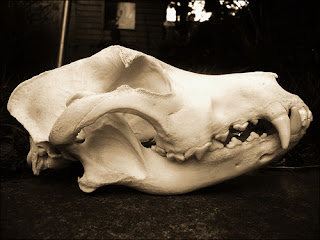The face of happiness - a mongrel in every form, theses dogs are rarely afflicted by breed-specific illnessess.
The Dog Blog Thing
Saturday, September 1, 2012
The Face of Perfection - Brachycephalic dogs
The face of happiness - a mongrel in every form, theses dogs are rarely afflicted by breed-specific illnessess.
Sunday, July 11, 2010
The Receding Topline

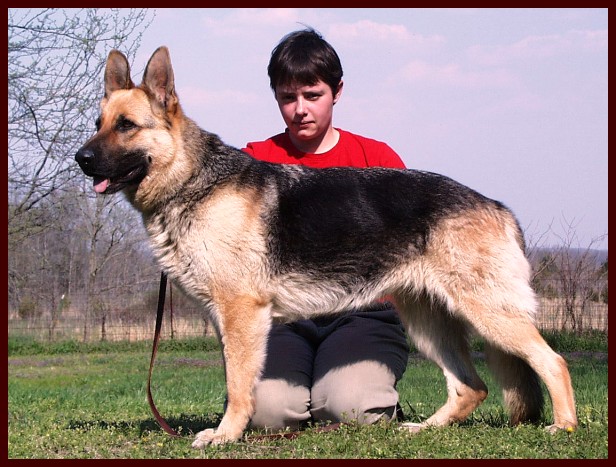 This type of topline has now been bred into a very sloped, long and stretched back. There is nothing square about this topline or dog, and although some of these dogs have a lovely appearance, too much breeding of these backs can gradually produce some very sloped offspring. This is what has happened over the last 50 years or so to the German Shepherd Dog. It has now become standard for these dogs to appear this way unless of working lines. Most of this is partly due to show breeders, but some also to pet breeders. the GSD is still a very popular breed but is beginning to appear unsound to pet owners. Below is an image of a GSD with a very bad topline. Sadly, these dogs are being accepted as quality show dogs in certain countries. These dogs may be brilliant show dogs that fit certain standards, but they do not necessarily make good pets.
This type of topline has now been bred into a very sloped, long and stretched back. There is nothing square about this topline or dog, and although some of these dogs have a lovely appearance, too much breeding of these backs can gradually produce some very sloped offspring. This is what has happened over the last 50 years or so to the German Shepherd Dog. It has now become standard for these dogs to appear this way unless of working lines. Most of this is partly due to show breeders, but some also to pet breeders. the GSD is still a very popular breed but is beginning to appear unsound to pet owners. Below is an image of a GSD with a very bad topline. Sadly, these dogs are being accepted as quality show dogs in certain countries. These dogs may be brilliant show dogs that fit certain standards, but they do not necessarily make good pets.
 The GSD is not the only breed of dog with this issue. It has affected many other breeds, however, I will only mention one more of these. That breed which also has gradually lost topline quality is the show Irish Setter. The original Irish Setter, as shown below in this old painting, was a square hunting dog with little coat and a variety of head shapes. The basic shape is the same, but the dogs of today have changed dramatically in various bady features, such as toplines, coat and heads.
The GSD is not the only breed of dog with this issue. It has affected many other breeds, however, I will only mention one more of these. That breed which also has gradually lost topline quality is the show Irish Setter. The original Irish Setter, as shown below in this old painting, was a square hunting dog with little coat and a variety of head shapes. The basic shape is the same, but the dogs of today have changed dramatically in various bady features, such as toplines, coat and heads. The hunting/gundog Irish Setters are very sound and have a very good topline. Below is a photo of a working Irish Setter. Although this dog has a sound topline, it lacks much of the beautiful hair of the show Irish.
The hunting/gundog Irish Setters are very sound and have a very good topline. Below is a photo of a working Irish Setter. Although this dog has a sound topline, it lacks much of the beautiful hair of the show Irish. 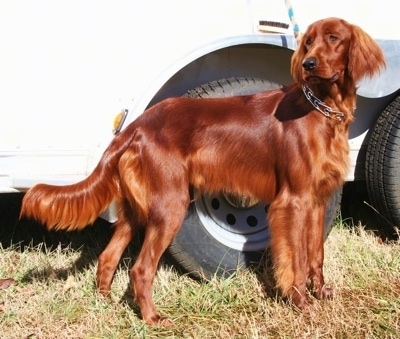
The Show Irish is very similar around the world, with the exception of a few different strains. The topline of the show Irish Setter is not the same as that of the working Irish, although it is not as extremely different as the GSD. Show Irish's tend to have a sloped topline and although these vary, the 'square' dogs are not usually prefferred. Below is a very sound, 'square' show Irish which resembles its forebearer somewhat. Although they are not considered more physically sound, the sloped Irish's are used most commonly as show dogs. These dogs, like the GSD, are good as show and pet dogs, but would be very impractical as working dogs because of their body shape. Below is an example of an Irish Setter with a sloped topline.

All images were found using google image search. Please note that these dogs are only examples and I consider them all beautiful specimins despite the issue in discussion.
Monday, July 5, 2010
The Doberman Pinscher types

Everybody knows about the Doberman Pinscher, right? A big black & tan dog with amazing guarding abilites, a bit like the Rottweiler? Wrong. There is a lot more to the Dobermann than meets the public eye, from all sorts of capabilities to temperaments and more. But today I will be focusing on the two main and very interesting 'types'. Before I start, however, its important to know what a 'type' is. In dog breeds, type is a slightly different physical appearance inside a breed. The dogs are all still similar and to the same standard, and therefore it would be silly to have to make that type into another breed. For example, making short-haired Border Collies seperate from long-hairs would be pointless because the only variation is the coat type. A type is also different to a 'strain', which is a specific line of pedigreed dogs bred by a certain breeder/s for a few decades. I will not be going into this field today but that also is a very interesting area.
There are two main Dobe types, those being the European and the American. The American type is most common in Australia and the US, and is often the only one recognised. So, below I have a seperate part for both types and even varitation, just so it's not too confusing. Enjoy!
The European Doberman Pinscher -

Is the type closest in resemblance to Lious' Dobermann's Dogs. These Dobies are a very heavy-built dog used mainly as schutzhund and Police Dogs. This is often refferred to as the 'working' strain of Dobies because they have been used for centuries and are still in use doing what they were bred for, unlike many breeds today.
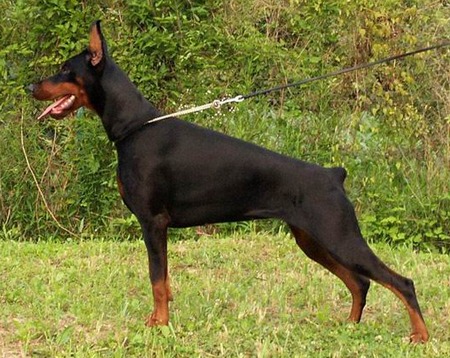 The European Dobies, obviously, live all over Europe and some are exported to breeders around the world. They are, however, only bred to their type to preserve the strong working instincts. These dogs are often very agressive and make brilliant guards. They can be unreliable and this is often due to the fact that they were bred for non-companionship reasons. This is probably the hardest to train and strongest type of the two.
The European Dobies, obviously, live all over Europe and some are exported to breeders around the world. They are, however, only bred to their type to preserve the strong working instincts. These dogs are often very agressive and make brilliant guards. They can be unreliable and this is often due to the fact that they were bred for non-companionship reasons. This is probably the hardest to train and strongest type of the two.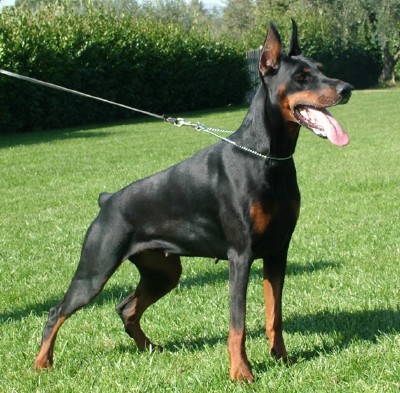 As for physical appearance, the Euro Dobermann is large, solid and muscular. He has a large, powerful head with a pointed muzzle, a long, thick neck, deep, broad chest, gradually sloped back and solid hindquaters. The legs are muscular are strong, and the paws are rounded and large. The ears are naturally large and folded down; but many breeders have these cropped and taped for a better appearance. The tail is thick, long and curled. It can be docked but in Europe it is usually left natural length with uncropped ears. This is the traditional type of Dobermann and is quite uncommon in show Dobes elsewhere.
As for physical appearance, the Euro Dobermann is large, solid and muscular. He has a large, powerful head with a pointed muzzle, a long, thick neck, deep, broad chest, gradually sloped back and solid hindquaters. The legs are muscular are strong, and the paws are rounded and large. The ears are naturally large and folded down; but many breeders have these cropped and taped for a better appearance. The tail is thick, long and curled. It can be docked but in Europe it is usually left natural length with uncropped ears. This is the traditional type of Dobermann and is quite uncommon in show Dobes elsewhere.The American Doberman Pinscher -
 Is a very common type worldwide. These Dobies are descended from the European type and have gradually changed type in America by the breeding of different, lighter dogs. The American Dobie is used in Police work and guard also, but is most commonly found in show and pet homes.
Is a very common type worldwide. These Dobies are descended from the European type and have gradually changed type in America by the breeding of different, lighter dogs. The American Dobie is used in Police work and guard also, but is most commonly found in show and pet homes. The showing of this type of Dobermann is extremely popular worldwide and this is the type shown mostly in Australia. There are also various kinds of American Dobies, but these all come roughly from the same dogs and should not be considered types. The show Dobes in Australia, for example, are all slightly different to those in America.
The showing of this type of Dobermann is extremely popular worldwide and this is the type shown mostly in Australia. There are also various kinds of American Dobies, but these all come roughly from the same dogs and should not be considered types. The show Dobes in Australia, for example, are all slightly different to those in America. The Physical apearance of the American Dobermann is somewhat similar to the Euro Dobie, but it is unmistakedly varied.
The Physical apearance of the American Dobermann is somewhat similar to the Euro Dobie, but it is unmistakedly varied.This Dobie is large, fine-boned and often ribby. His head is large but light, with a long pointed nose, and a thin, slender neck. The back is straight, the chest is deep and tucked up high into the stomach. The legs are long and fine, with solid, round paws. The ears of show American Dobes are always cropped, and the tail is always docked short. This is the typical American Dobermann type, with the exception of a pet with natural ears.
So, there you have it. The two Doberman Pinscher types with beautiful photos from allover the web. Comments, anyone?
Monday, June 21, 2010
The first post!

First of all, welcome all dog nuts! Here's the place to be. Especially those of you that love looking for random doggy bits that you can than go and rave on about - see, we have something in common already!
So, a quick intro on me. I'm almost 16, am a dog - crazy kind of person and love animals. I will be starting volunteer work at two vets in July for my TAFE course, but more on that later. I love writing, art and drawing, especially drawing dogs; no, mainly dogs. =) I also really love photography and playing guitar. And doggy agility, which is really neat, dog training, too.
..... Oh - and I really, really, really want to start showing dogs, hopefully when I get my first pedigree dog. But that's not for a while.
So. That's about it. So enjoy!
~AJ~
(The picture above [Bullmastiff] is a dog I found on Google which I am pretty sure is not copyright. The photos used in this blog will be not copyright if possible and it will be stated when the work is not my own. I will also regularly add my own photos.)




